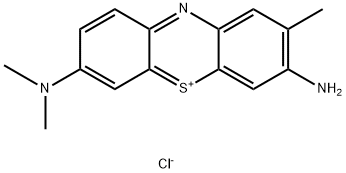| Chemical Properties | green powder |
| Originator | Blutene,Abbott,US,1953 |
| Uses | A metachromatic dye suitable for a wide variety of histological staining procedures. |
| Uses | Direct dyeing, printing of wool, silk. Biological stain. |
| Uses | hemostatic |
| Preparation | by heavy chromate salt in the presence of sodium content and deal with N1,N1-dimethylbenzene-1,4-diamine, transforming it into the content and sulfonic acid, this product then through heavy chromate salt and O-Methylaniline processing, into a unique of sulfur acid amine generation, then use heavy chromate salt and copper sulfate closed loop and oxidation, Finally,?the?zinc chloride?salt?precipitation |
| Definition | ChEBI: An organic chloride salt having 3-amino-7-(dimethylamino)-2-methylphenothiazin-5-ium (tolonium) as the counterion. It is a blue nuclear counterstain that can be used to demonstrate Nissl substance and is also useful for staining mast cell granules, both i metachromatic and orthochromatic techniques. |
| Manufacturing Process | As taken from US Patent 416,055 (probably the oldest patent on the manufacture of a currently-used drug): In carrying out this process about 6 pbw of dimethyl-p-phenylenediamine was dissolved in about 18 pbw of hydrochloric acid of about 1.16 specific gravity and then a solution of about 3.8 pbw of nitrite of soda in about 6 pbw of water was gradually added. The hydrochlorate of nitroso-dimethylaniline thus produced in the well-known manner is then submitted to the reducing action of zinc-dust by adding, first about 30 pbw of hydrochloric acid of about 1.16 specific gravity and then (in small portions at a time) about 10 pbw of zinc-dust as is well understood by chemists. The solution of hydrochlorate of paramido-dimethylaniline thus obtained is afterwards diluted with about 250 pbw of water and then the uncombined hydrochloric acid contained in the solution is, if any, neutralized by the addition of an alkali. There are then added about 16 pbw of sulfate of alumina and about 13 pbw of thiosulfate of sodium, (hyposulfite of soda) and immediately afterwards a solution of about 5 pbw of bichromate of potash in about 60 pbw of water is quickly run in.
In this stage of the process the formation of an acid sulfureted compound of paramidodimethylaniline takes place, possessing the formula C8H11N2SSO3H(paramido-dimethylaniline-thiosulfonic acid). Without previous separation of this intermediate compound a solution of about 5.3 pbw of orthotoluidine, in the requisite amount of dilute hydrochloric acid (about 6 pbw of hydrochloric acid, SG about 1.16, diluted with about 6 pbw water) and shortly afterwards a solution of about 14 pbw of bichromate of potash in about 160 parts by weight of water is then added under constant agitation, when a precipitate will be formed chiefly consisting of a green indamine possessing in its dry condition the formula C15H17N3S2O3. In order to transform the same into toluidine-blue, about 50 pbw of a solution of chloride of zinc of about 1.5 specific gravity are added and the mixture thus obtained is boiled during about half an hour, when, after cooling, the toluidine-blue thus formed will separate out and may then be filtered and purified, if necessary, by repeated solution in water and precipitation by means of chloride of sodium and chloride of zinc.
In the above described process the sulfate of alumina may be dispensed with and replaced by as much hydrochloric, sulfuric, or acetic acid as will be required to liberate the thiosulfuric acid from the thiosulfate of sodium employed.
Toluidine-blue prepared as above described presents the following characteristic properties: It consists principally of the hydrochlorate of dimethyltoluthionine, the composition of which corresponds to the formula C15H15N3SHCl. |
| Therapeutic Function | Coagulant |
| Properties and Applications | Soluble in water for blue purple, soluble in ethanol to blue. The strong sulfuric acid for yellow green, diluted to blue. The dye solution to join sodium hydroxide have dark purple precipitation.
Standard( Cotton )Light FastnessPersperation FastnessIroning FastnessSoapingFadingStainFadingStainFadingStainC2-31-2 |
